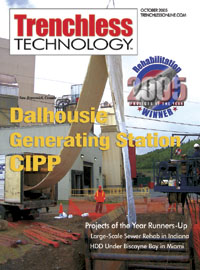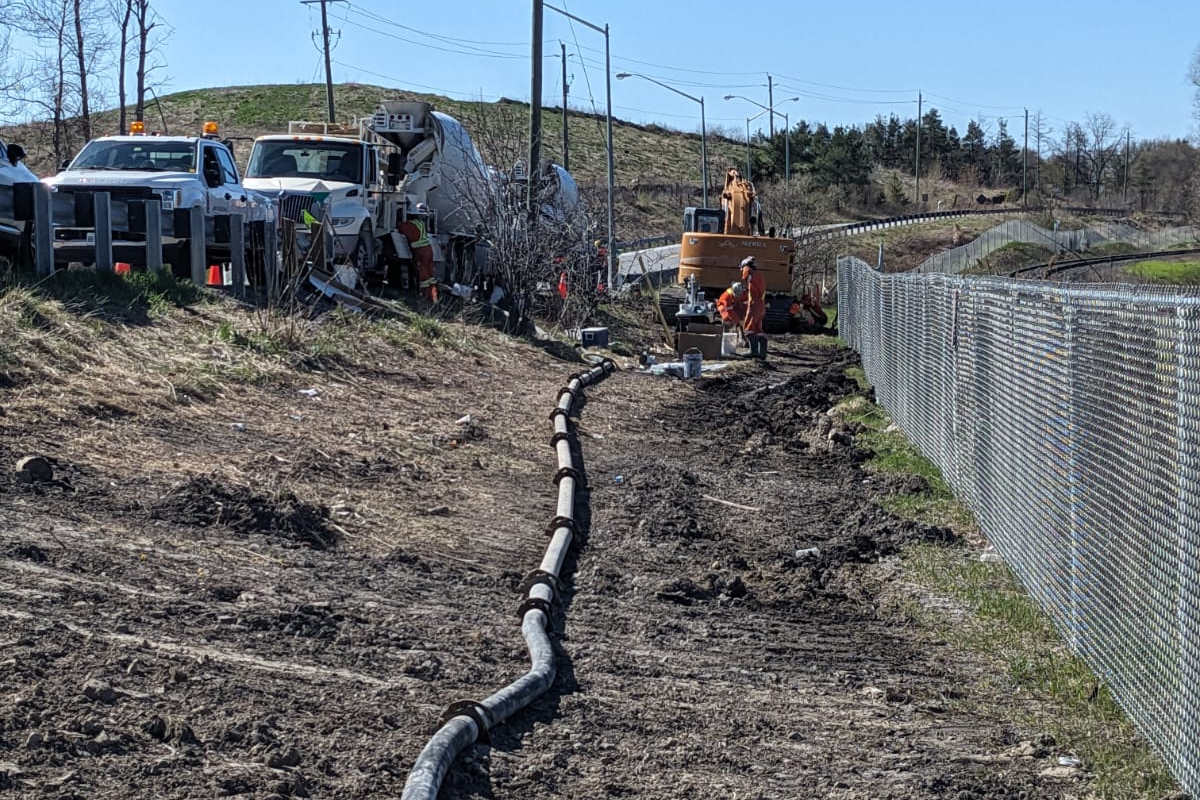2005 Rehabilitation Winner

The northernmost portion of the province is sparsely populated and seems an unlikely place for progressive trenchless methodologies, but nonetheless served as the setting for the 2005 Trenchless Technology Project of the Year —Rehabilitation.
Situated at the junction between the Restigouche River and the Chaleur Bay,the Town of Dalhousie is home to the Dalhousie Generating Station, anOrimulsion-fired plant that provides up to 320 megawatts of power per day. Theplant, originally commissioned in 1969, was the first in the world to undergoconversion to burn Orimulsion, a bitumen-based fuel that is mixed with freshwater and surfactant.
Over the years, intake and discharge lines leading from the bay to theinterior of the generating station became deteriorated, causing leaks in thelines that began showing up in the interior of the facility. In addition, thecapacity of the lines was reduced due to mollusks that attach themselves to theinside of the lines.
Because the Dalhousie Generating Station, which is owned and operated by NewBrunswick Power Corp., supplies power to a large area of New Brunswick, plantshutdowns for maintenance and repair are strictly scheduled to limit impact onthe power grid. As a result, any rehabilitation of the intake and dischargelines had to be done quickly.
Scope of Work
The Dalhousie projectinvolved the installation of two 48-in. diameter cured-in-place pipe (CIPP)liners, 22.5 mm thick. The first liner was 430 ft in length and the
secondwas 520 ft, both installed using inversion technology and hot water curing ofvinyl ester resin.
In addition to the two horizontal intake and discharge lines, six verticallines were also repaired using vinyl ester resins cured ambiently. Two of thespot repairs used 24-in. diameter liners 19.5 mm thick and 4 ft in length, whilethe other four vertical spot repairs were 36-in. in diameter, 22 mm thick andbetween 10 to 15 ft in length. The vertical drops were located inside thebuilding and did not provide sufficient headroom to allow an inversion.
The tender for the project closed April 21, 2005, and was awarded May 4 toSARP Sewer-Matic, Ottawa, Ontario. Installation was scheduled to start June 3during the scheduled plant shutdown and was to be completed by June 20 incoordination with other repairs being performed on various parts of thegenerating station.
Using ambient cure for the spot repairs created logistical challenges for theSARP Sewer-Matic crews.
First, crews had to deal with traffic created by other trades performingrepairs independent of the pipelines. Second, the resins used for the ambientcure left little room for error.
“There is a window of about an hour and a half to an hour and 45 minutesbefore the resin starts to cure,” said Sandy Campbell, project superintendentfor SARP Sewer-Matic. “It took us about 45 minutes to wet out the liners with900 lbs of resin, and it took about 20 to 30 minutes to place the liner in thepipe, so there were some stressful times as these shots were completed. We wereracing the clock to get in and get out.”
The spot repairs also required the use of specially designed, double-skinnedbags — an inner layer to maintain air pressure needed to shape the bag withinthe pipe and the outer layer to contain the resin.
Originally, New Brunswick Power considered replacing the intake and dischargelines by open-cut. However, upon conferring with its consultant, Mill CreekManagement, New Brunswick Power opted for the less invasive trenchlessoption.
“The owner wanted to replace by open-cut, but that was notcost-effective for a number of reasons,” said George Vernon, president of MillCreek Management, Mill Creek, Wash. “First, the lines crossed under an importantaccess road that would make all the repairs planned for the shutdown difficultfrom a logistics standpoint. Second, it would have required excavating along thefoundation and into the building itself, which would have increased costs. And,it would have added days to an already aggressive schedule.”
Both 48-in. inversion tubes were wet out at SARP Sewer-Matic’s facility inOttawa where unusually hot weather pushed inside temperature to 90 degrees. Inorder to compensate for the extreme heat, crews designed and built a temporarystructure over the roller systems and installed four portable air conditionersto maintain a steady temperature of 65 degrees.
The largest of the tubes required 24,000 lbs of resin and took 24 hours towet out. Once it was loaded onto the reefer truck, it was driven non-stop to NewBrunswick — a 15-hour drive. The second tube, which required 20 hours to wetout, followed two days later.
The two liners were installed from excavation pits on the 48-in. lines, closeto the shore, to a dead-end steel flange. Including the inversion column head,the liners had a grade differential from the top to the bottom end of 10 ft and17 ft, respectively. Included in those drops, each 48-in. diameter steel linehad one 45-degree horizontal bend, and two 90-degree vertical drops, each 6 ftin length. The operating pressure of the lines was 25 psi.
Because the tail could not be cut, nor the curing water discharged, smallholes were drilled into the liner through the 36-in. access points and several3-in. submersible pumps were installed to drain the liner. Followinginstallation and cure, six vertical entry points in the pump house had to bere-instated and sealed with fiberglass to ensure water tightness.
Successful Completion
Said Vernon: “Theproject went well and met the scope of work. The combination of resources thatwere brought together is what made it a success, particularly the experience ofthe people installing the liner.”
Other companies involved on the project include Interplastic (vinyl esterresin supplier) and Liner Products (tube supplier). The project may also serveas a test case for the use of plastic liners in intake and discharge lines as apossible means to combat the proliferation of mollusks. “I was working atanother power plant and placed vinyl ester coupons inside an intake pipeline fortwo years,” Vernon said. “When I went back two years later, I found thatmollusks had not attached themselves to the coupons. This material could be away to reduce buildup in the pipe and prolong the structural integrity andcapacity of the pipeline.”
The Dalhousie project shows that trenchless technology has a bright futurebeyond the conventional municipal market. Also, the use of ambient cure resinsinside the building shows the flexibility of trenchless methods in a variety ofsettings.
“This was a challenging project on all parameters — the physical constraints,the schedule, complications due to working with other trades and the stressfactor,” Campbell said. “This is definitely among the most difficult projectsI’ve worked on, but the people we were working for were excellent.”




